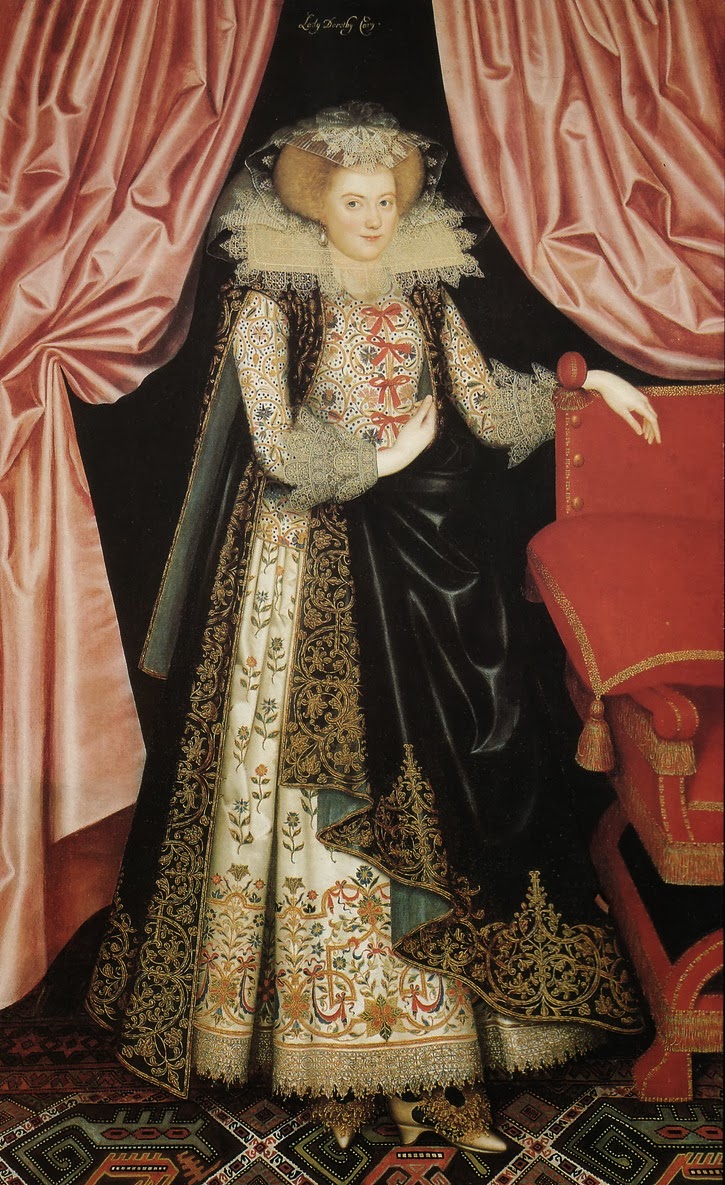Spangles, Sequins, and Spangs, Oe My!
4:24 PM
"The Robe she ware was lawne (white as the Swanne)
Which silver Oes and Spangles over-ran
That in her motion such reflexion gave,
As fill'd with silver stares, the heav'nly wane."
- John Davies of Hereford, An Extasie, 1603
What better way to return from a long hiatus than with a flurry of sparkles? Today's post is all about sequins, spangles, and oes!
 |
| French court suit jacket, 1750-75. The Metropolitan Museum of Art. |
For centuries, the fashionable have decorated their clothing and accessories with small, reflective metal discs. Today we know these as sequins, but in previous centuries they were known as spangles. According to the Oxford English Dictionary, the first recorded use of sequin as a name for these sparkly discs was in 1882. A few centuries earlier, a sequin was the name of an Italian gold coin. Perhaps this reference to a small disc of precious metal inspired the later use of the word.
In the 17th and 18th centuries, sequins were known as spangles or spangs. Spangles were made of precious and semi-precious metals such as gold, silver, and copper, and came in a variety of shapes and sizes. The most common was the flat, circular disc we are familiar with today. But by the end of the 18th century, spangles could be cut into multiple shapes like clovers and hearts, and could be tinted colors like pink and blue. In many descriptions, such as the poem at the beginning of this post, spangles are paired with oes. Oes were another form of decorative metal detail, very similar to spangles. According to scholar M. Channing Linthicum, "oes were metal eyelets tacked or clinched to the material in such designs as 'squares,' 'Esses,' 'wheate eares,' etc., or powdered over the whole surface."
 |
| Lady Dorothy Cary by William Larkin, c. 1614. English Heritage. The little spots on her embroidered jacket are spangles. |
According to records of English parliamentary proceedings, in 1575 "a Patent was first granted to Robert Sharp to make Spangles and Oes of Gold." This suggests that Robert Sharp was perhaps one of the first English manufacturers of spangles and oes, or perhaps an innovator in their production. There were two methods for creating spangles. In the first method, a thin coil of wire was wrapped around a narrow dowel. The resulting spring was then cut and the coils hammered flat to create round discs with a small hole in the middle. The second method was used to create spangles with more elaborate shapes. In this method, a thin sheet of metal was laid out and the spangles were punched out using shaped tools, like when you make cookies with cookie cutters.
Spangles and oes were used to decorate the clothes and accessories of men and women. In the candle light, they would shimmer and lend a magical quality to the wearer. In an essay by Francis Bacon, titled Of Masques and Triumphs, the glittering effect of spangles and oes is described. He writes, "The colors that show best by candle-light are white... and oes, or spangs, as they are of no great cost, so they are of the most glory."
 |
| Women's Jacket made in Great Britain, 1600-1625. The Victoria and Albert Museum. |
Over the years, spangles and oes have decorated a variety of garments and accessories. One of the most notable uses was in the first decades of the 17th century when they covered women's embroidered jackets, as in the above image. From 2007 to 2009, workers at Plimoth Plantation meticulously reproduced one of these embroidered jackets. To read more about this incredible undertaking, including their manufacturing of spangles, I highly recommend their blog.
 |
| Detail of a French court suit embroidered with blue tinted spangles, 1750-75. The Metropolitan Museum of Art. |
In the 18th and early 19th centuries, spangles could often be found on decorative embroidery. The above image is a detail of the court suit pictured earlier in this post. Here you can see a variety of spangles, from plain gold circles to blue tinted circles and pointed ovals. As for the tightly coiled wires which surround many of the spangles, could they be oes?



1 comments